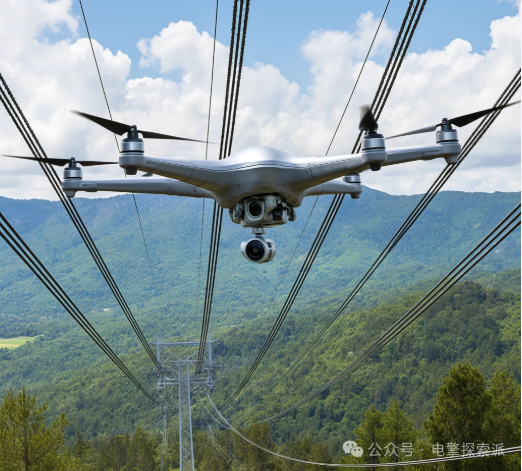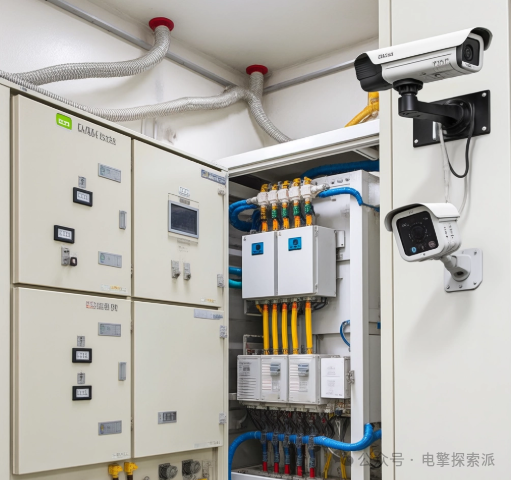In the late night at the substation, cameras silently rotate. In the past, these devices could only record footage, waiting for manual inspections; now, with the help of edge AI video recognition technology, they can capture hazards such as equipment overheating, insulator breakage, and foreign object intrusion in real-time, issuing alerts within milliseconds. The power industry is undergoing an intelligent transformation driven by edge AI—eliminating the need for cloud reliance, with computing power pushed down to the device level, shifting power operation and maintenance from “post-event response” to “pre-event warning.” How is this technology being implemented? How will it change the industry?
Differences Between Edge AI and Cloud AI
Many of the AI models we currently use rely on cloud computing, which means that edge devices need to send the data they perceive to a server cluster deployed in the cloud, where algorithms process the data and return the results. However, relying on cloud computing is not always ideal, especially when considering real-time data processing, data privacy issues, and the need for reliable connectivity.
This is where edge artificial intelligence comes into play. Edge AI focuses on deploying algorithm models directly on edge devices, such as cameras or sensors, enabling immediate and reliable on-site decision-making. The goal of edge computing is to process data near its source, typically on local servers or gateways, rather than relying on the cloud. This shift reduces latency, enhances privacy, and allows AI to operate efficiently even without continuous cloud access.Edge AI models can process tasks such as image recognition, speech processing, and predictive maintenance in real-time, rather than constantly sending data back and forth to the cloud. This capability is made possible by the computational power of edge AI and the iterative advancements in algorithms, allowing powerful models to run efficiently on compact devices. Edge AI is particularly useful in computer vision applications that require immediate processing of large amounts of visual data. Computer vision models, such as RF-DETR and Ultralytics YOLO11, can perform tasks like object detection and instance segmentation directly at the edge, powering AI systems.
What is the Difference Between Edge AI and Edge Computing?
Although edge AI and edge computing sound similar, they serve different purposes. Edge computing is a broader concept that involves processing data at or near the edge, such as on edge servers, gateways, or devices. The focus of edge computing is to reduce the amount of data sent to centralized servers by processing tasks locally. It supports everything from data filtering and analysis to running complex applications outside traditional data centers. In contrast, edge AI specifically refers to AI models running on edge devices. In short, edge AI brings intelligence to the edge. Together, these technologies provide low-latency AI computing for industries that rely on speed and efficiency.
For example, smart cameras can use edge computing to transmit video streams but rely on edge AI to analyze the video stream, detect anomalies, and trigger alerts.
Practical Applications of Edge AI
Case 1: The “AI Line Inspector” for Ultra-High Voltage Lines
Pain Point: Traditional manual inspections require climbing hundred-meter towers, which are inefficient and risky.
Solution: Deploy inspection drones equipped with edge AI chips to identify defects such as broken wires and loose bolts in real-time.
Results: Inspection time reduced from 5 days to 2 hours, with defect identification accuracy exceeding 98%.

Case 2: The “24-Hour AI Safety Officer” for Distribution Rooms
Pain Point: Old distribution rooms are prone to short circuits caused by small animal intrusions.
Solution: Embed rodent and snake recognition models in cameras to activate sound and light deterrent devices upon detection.
Results: Zero animal intrusion incidents in a pilot area of a coastal city, with operational costs reduced by 40%.

Advantages and Challenges of Edge AI
Advantages
1. Low Latency: Edge AI minimizes latency through local data processing, enabling immediate responses in critical applications like industrial automation.
2. Strong Security: Edge AI can keep data on devices, reducing exposure risks, making it ideal for applications that require privacy considerations.
3. Reduced Bandwidth: Edge AI minimizes the frequency of data transmission to the cloud, helping to lower operational costs and improve efficiency.
4. High Efficiency: Running models locally supports energy-efficient AI operations, especially suitable for low-power edge devices in IoT environments.
Challenges
1. Computational Bottlenecks: Power devices need to run complex algorithms (like YOLO model compression) under low power conditions;
2. Complex Scenarios: Recognition accuracy drops sharply in extreme weather conditions like heavy rain and fog;
3. Data Silos: Difficulty in data interoperability between different enterprises, leading to weak model generalization capabilities;
4. Long Tail Problem: Rare fault samples are scarce.
5. Maintenance and Updates: Managing and maintaining a large number of distributed edge devices is a challenge.
6. High Initial Costs: Establishing edge infrastructure and dedicated hardware may require significant upfront investment, but can reduce cloud costs over time.
Future Outlook
1. Focus on developing models for specific scenarios (e.g., dedicated algorithms for arc recognition);
2. AI + Digital Twin: Video data-driven 3D models for fault simulation and response planning;
3. AI + Blockchain: Key alert information recorded on the blockchain to meet the stringent regulatory requirements of the power industry.
From “human eye inspections” to “AI smart eyes,” edge artificial intelligence is redefining power safety. As technology penetrates every corner of substations, transmission towers, and distribution rooms, we are not only witnessing a revolution in efficiency but also an elevation of the entire energy system’s safety.
The future is here—behind the next bright lights, there may be a pair of AI “eyes” silently watching over. Let every kilowatt-hour flow safely under the protection of AI.
How do you expect edge artificial intelligence to change the power industry? Feel free to discuss!